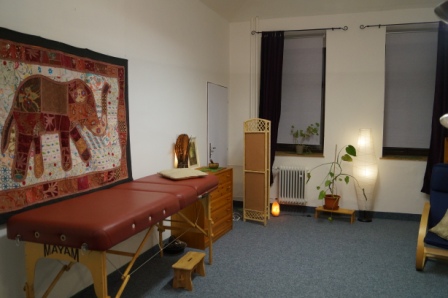What is the aim?
– The client is in better contact with him/herself.
– My presence is felt in a holistic way, directly linked to the ongoing processes and not only those which are expressed by words.
Being in contact, giving space to what is happening, the actualizing tendency can find more space and be active.
See videos: 1)Interview – 2)Description
 Practically
Practically
Every Mindful Touch Therapy session starts and ends with a possibility of talking.
Especially in the first session I give information about what this body-work is about:
– It concerns psychological problems, not excluding somatic questions but no medical advice is given and there is no medical or physio-therapeutic aim
– The practical setting is not defined but at disposal and cane chosen by the client, this is part of the bodywork process. Generally lying on the massage table is chosen for it’s comfort.
– The client explores what is going on in the organism, the therapist tries to be in contact with what is going on, but this does not mean cognitive explanations or interpretation.
– Both are free to talk or not during the body-work
– The client is invited to be especially attentive to what seems right for her/him : this is not about obtaining some result nor reacting to therapist’s proposals, but to check permanently if the attention is on the right place, if the touching is adequate, if it is necessary to talk or not, if some body-parts need more or less attention.
– Even if we agreed on body-work, the client (or therapist) might be aware that it is not the right moment to do so, that touching might be wrong in that moment.
These introductory points are necessary in order to give the frame and freedom of this person-centred body-work, getting away from concepts of psychosomatic practices in which the therapist proposes technical competence or knowledge. Here, the unique power stays within the client, as long as the introductory information is accepted and as the therapist definitively integrates them.
I consider as the main challenge of this type of work in maintaining the initiative at the client’s place; especially as the setting gives already a lot of initiative power to the therapist.
The technique, or attitude, is “being with”, “listen”, “accompany”, “welcome whatever might be there”, not falling into mechanic reactions (massage techniques, research of resisting points, analysis of body-language, …).
Outcome
Talking and thinking often gives grips for the mentalizing self to interfere in the process, this little voice of Gendlin’s critic preventing from healthy thinking and feeling. Listening to the body clearly disarms the critic. So some moment of body-work can help the client to go deeper in contact with her/himself, keeping linked to the reality of the person and the relationship. For example, Mary, experiencing herself as too fat and being angry about that, could simply experience her body, face it openly and get into calmer relation to it.
The client is directly connected to her/his experiential process which may go on in a very deep way. Talking about her eyes, in pain, Suzan expressed verbally that something is blocked. Touching the eyes, she said feeling suddenly that she had eyes and not only a pain-center and could “listen” to the blocking instead of talking about it. The blocking was about not taking her place in the world.
As the body is linked to many taboos, these taboos are like a wall hiding the real experience. Fear, apprehension, phantasm, projection hold back our real experience. A body-oriented listening invites to the direct experience. And as there is no guidance, judgement or analysis, trust in the inner process can grow rapidly. Several clients realized their sexual blocking when touching the hips. They could come to more openness of their energy, thus without going towards sexual desire.
The distinction between somatic and psychosomatic problems is clarified; it is easier to check which problems are linked to emotions, thoughts or medical issues (tick of head shaking different to experience of multiple scleroses symptoms).
Anxiety can easier be reduced because the clients do not need to “hold” themselves all the time, they can go deeper into the reality of the concrete feeling, the wideness of the anxiety, not obliged to fight against it and they can feel that there is not only fear in the organism but also other emotions. Like in Focusing, permanent verbal verification is necessary in order to check if the clients are ready to explore that anxiety so that tey are in connection with the ability to stop the exploration, feel other emotions or body-sensations and keep aware of the situation. Client with anxiety paralysed from rising from bed, having multiple cross-reactions during body-therapy.


